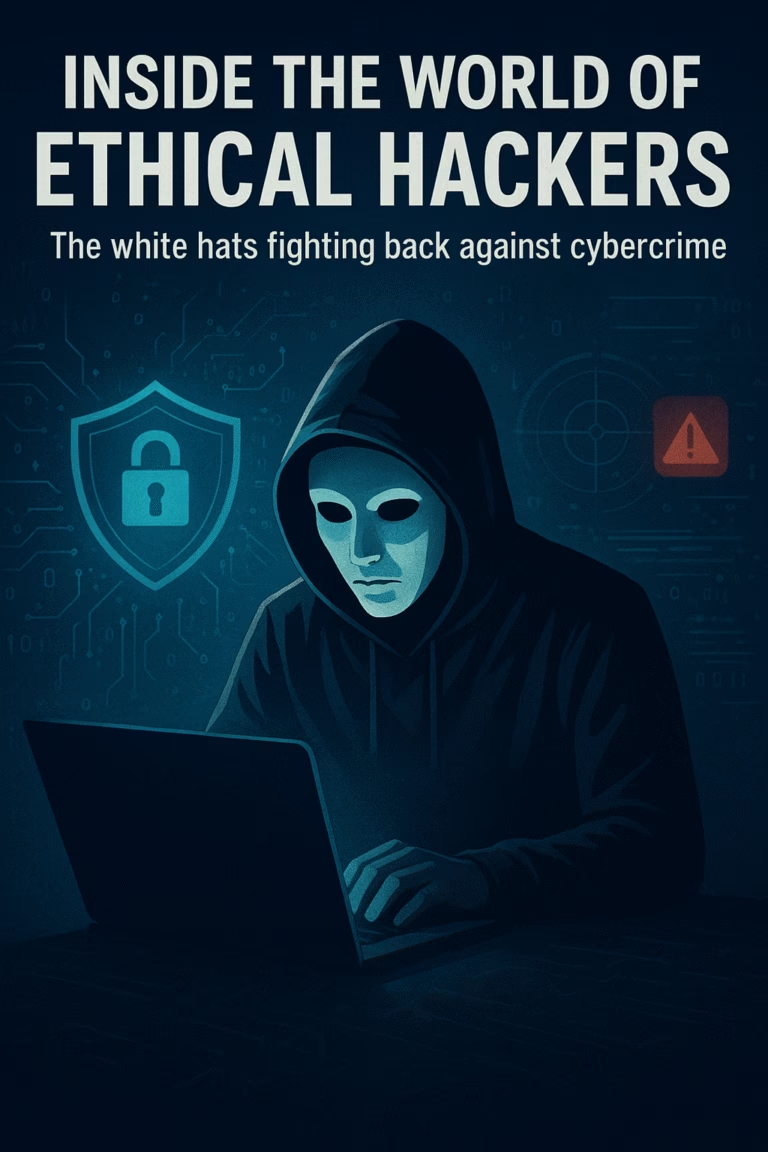The white hats fighting back against cybercrime
In a dimly lit room somewhere across the globe, a hacker’s fingers dance across the keyboard, probing networks, searching for weaknesses, and exploiting vulnerabilities. But this isn’t a scene from a cybercrime thriller—this is the daily work of an ethical hacker, one of the unsung heroes defending our digital frontier.
While cybercrime costs are projected to reach astronomical heights in 2025, a specialized community of security professionals known as white hat hackers or ethical hackers are working tirelessly to turn the tide. These cybersecurity specialists use the same tools and techniques as malicious hackers, but with one critical difference: they have permission, and they’re on our side.
The Rising Stakes of Cybersecurity
The numbers paint a sobering picture of our digital vulnerability. According to IBM’s latest research, the average cost of a data breach has soared to $4.88 million per incident. Organizations worldwide face an unprecedented wave of cyber threats, from ransomware attacks that can paralyze entire hospital systems to sophisticated phishing campaigns that drain corporate bank accounts in seconds.
This is where ethical hackers enter the battlefield. These professionals operate within strict legal and ethical boundaries, using their hacking expertise to identify security flaws before criminal actors can weaponize them.
Who Are the White Hats?
Ethical hackers—often called white hat hackers, penetration testers, or security researchers—are cybersecurity experts who specialize in offensive security. Unlike their malicious counterparts (black hat hackers), white hats work with explicit permission from organizations to probe systems, networks, and applications for vulnerabilities.
The journey into ethical hacking varies widely. Some, like cybersecurity specialist Matt Jakubowski, began as curious teenagers modifying video games and exploring how systems work. Others come from traditional IT backgrounds, transitioning into security after years of system administration or software development. What unites them is an insatiable curiosity about how things work—and how they can be broken.
The Hacker Spectrum: Understanding the Different Hats
| Hacker Type | Motivation | Legal Status | Primary Activities |
|---|---|---|---|
| White Hat | Security improvement, protection | Legal (with permission) | Penetration testing, vulnerability assessment, security auditing |
| Black Hat | Personal gain, malicious intent | Illegal | Data theft, system damage, ransomware, fraud |
| Grey Hat | Mixed motives, often ego-driven | Legally ambiguous | Unauthorized testing, sometimes disclosing vulnerabilities publicly |
| Blue Hat | Revenge, personal vendettas | Typically illegal | Targeted attacks against specific individuals or organizations |
| Red Hat | Vigilante justice against black hats | Legally questionable | Attacking malicious hackers, taking down black hat operations |
The Ethical Hacker’s Arsenal
Ethical hackers employ an extensive toolkit to assess security postures. Their methodologies mirror those of actual attackers, ensuring that vulnerabilities are discovered before criminals can exploit them. Here’s what their typical workflow involves:
Key Testing Phases
- Reconnaissance: Gathering intelligence about the target system, including network infrastructure, employee information, and publicly available data
- Scanning and Enumeration: Identifying live hosts, open ports, running services, and potential entry points
- Vulnerability Assessment: Systematically testing for known weaknesses using automated tools and manual techniques
- Exploitation: Attempting to gain unauthorized access to demonstrate the severity of discovered vulnerabilities
- Post-Exploitation: Assessing what data could be accessed or compromised and understanding the full impact
- Reporting: Documenting findings with clear remediation recommendations and risk assessments
Popular Tools of the Trade
Professional ethical hackers rely on both commercial and open-source tools, including:
- Metasploit: A comprehensive penetration testing framework
- Burp Suite: Web application security testing platform
- Nmap: Network discovery and security auditing tool
- Wireshark: Network protocol analyzer
- Kali Linux: A specialized Linux distribution packed with security tools
- SQLMap: Automated SQL injection and database takeover tool
For a comprehensive list of the top tools used in 2025, the EC-Council maintains an updated resource showcasing the 100 best ethical hacking tools.
The Bug Bounty Revolution
One of the most significant developments in ethical hacking is the explosive growth of bug bounty programs. These initiatives allow organizations to crowdsource security testing by offering monetary rewards to hackers who discover and responsibly disclose vulnerabilities.
The numbers are staggering. HackerOne, one of the leading bug bounty platforms, recently announced that it paid out $81 million to ethical hackers over the past year—a 13% increase year-over-year. This represents a fundamental shift in how organizations approach cybersecurity, treating talented hackers as valuable partners rather than potential threats.
Major Bug Bounty Programs
| Organization | Focus Area | Notable Statistics |
|---|---|---|
| Meta (Facebook) | Social media platforms, mobile apps | Over $320,000 awarded in 2024; hosts annual Meta Bug Bounty Research Conference |
| Microsoft | Operating systems, cloud services, software | Runs comprehensive Microsoft Bug Bounty Program with rewards up to $250,000 |
| Web services, Android, Chrome | Google Vulnerability Reward Program has paid out over $50 million since inception | |
| Apple | iOS, macOS, hardware security | Apple Security Bounty offers up to $1 million for qualifying vulnerabilities |
| HackenProof | Web3 and blockchain projects | Over 200+ active cryptocurrency bug bounty programs with $15.7+ million in total payouts |
The blockchain and Web3 sectors have emerged as particularly lucrative hunting grounds, with Immunefi and other platforms offering some of the highest bounties in the industry. In 2023 alone, $65 million was distributed across blockchain bug bounties, reflecting the critical need for security in decentralized finance.
Real-World Impact: Stories from the Front Lines
The work of ethical hackers has prevented countless disasters. When a security researcher discovers a critical vulnerability in hospital systems before ransomware operators can exploit it, lives are literally saved. When ethical hackers identify flaws in banking applications, they protect millions from financial fraud.
Consider the case of “bionic hackers”—a term recently coined to describe ethical hackers who leverage AI and machine learning tools to enhance their capabilities. This new generation is discovering vulnerabilities faster and more efficiently than ever before, creating an arms race between security defenders and malicious actors.
The European Union and the United States federal government have both established formal bug bounty programs, recognizing that even critical infrastructure benefits from crowdsourced security testing. This represents a remarkable evolution in governmental approach to cybersecurity.
The Ethics and Legality
What separates ethical hackers from cybercriminals isn’t just their intent—it’s authorization. White hat hackers always work with explicit permission, typically formalized through contracts, bug bounty program terms, or authorized penetration testing agreements.
This legal framework is crucial. Without proper authorization, even well-intentioned hacking can result in criminal charges under computer fraud and abuse laws. The line between ethical research and illegal access is bright and must never be crossed.
The Ethical Hacker’s Code
Professional ethical hackers adhere to strict principles:
- Always obtain written authorization before testing any system
- Respect the scope of engagement and never exceed authorized boundaries
- Protect confidentiality of discovered vulnerabilities until they’re patched
- Never cause intentional damage or data loss during testing
- Provide clear, actionable remediation guidance to organizations
- Follow responsible disclosure practices when reporting vulnerabilities
Organizations like the HackerOne Knowledge Center provide extensive resources on ethical hacking best practices and community standards.
Becoming an Ethical Hacker: The Path Forward
The demand for skilled ethical hackers has never been higher. As cyber threats evolve and multiply, organizations across every sector desperately need professionals who can think like attackers to build better defenses.
Essential Skills and Knowledge
Aspiring ethical hackers should develop expertise in:
Technical Foundations:
- Networking protocols (TCP/IP, HTTP, DNS, etc.)
- Operating systems (Linux, Windows, macOS)
- Programming languages (Python, JavaScript, Bash, PowerShell)
- Web technologies (HTML, CSS, JavaScript, SQL databases)
- Cryptography fundamentals
Security-Specific Knowledge:
- Common vulnerability types (OWASP Top 10)
- Exploitation techniques and methodologies
- Security tools and frameworks
- Incident response procedures
- Compliance standards (PCI-DSS, GDPR, HIPAA)
Professional Certifications
While not always required, certifications can validate skills and open doors:
- Certified Ethical Hacker (CEH) – Entry to intermediate level
- Offensive Security Certified Professional (OSCP) – Highly respected hands-on certification
- GIAC Penetration Tester (GPEN) – Advanced penetration testing
- Certified Information Systems Security Professional (CISSP) – Broad security knowledge
- CompTIA Security+ – Foundational security certification
Resources like GeeksforGeeks’ ethical hacking guide and numerous online platforms offer structured learning paths for aspiring security professionals.
Practical Experience
Theory alone isn’t enough. Future ethical hackers need hands-on practice in safe, legal environments:
- Capture The Flag (CTF) competitions: Gamified security challenges
- Vulnerable-by-design applications: Like DVWA, WebGoat, and HackTheBox
- Bug bounty programs: Start with programs that welcome beginners
- Home lab environments: Build your own testing infrastructure
- Open-source contributions: Contribute to security projects
The Future of Ethical Hacking
As we progress through 2025 and beyond, the role of ethical hackers will only grow more critical. Emerging technologies like artificial intelligence, quantum computing, and the Internet of Things create new attack surfaces that require innovative defensive approaches.
The integration of AI into both offensive and defensive security tools is transforming the landscape. “Bionic hackers” who can effectively leverage machine learning models to identify patterns and anomalies represent the cutting edge of the profession. Yet the fundamental human skills—creativity, persistence, and ethical judgment—remain irreplaceable.
Emerging Trends
- AI-Assisted Security Testing: Machine learning tools that augment human capabilities
- Cloud Security Specialization: As organizations migrate to cloud infrastructure, cloud-specific security expertise becomes crucial
- IoT and OT Security: Protecting industrial control systems and smart devices
- Supply Chain Security: Vetting third-party software and dependencies
- Zero Trust Architecture: Implementing continuous verification security models
A Growing Community
The ethical hacking community is remarkably collaborative and knowledge-sharing. Security conferences like DEF CON, Black Hat, and EkoParty bring together thousands of researchers to share discoveries, techniques, and camaraderie. Online communities, Discord servers, and Twitter (X) security circles foster daily collaboration and mentorship.
According to Wikipedia’s comprehensive overview, the ethical hacking field has evolved significantly since its early days, growing from a niche specialty into a mainstream, highly valued profession. The collaborative nature of the security community accelerates learning and helps defenders stay ahead of evolving threats.
The Bottom Line: Digital Guardians
As cyberattacks grow more sophisticated and costly, ethical hackers stand as our first line of defense. These professionals don’t just find bugs—they prevent disasters. They protect hospitals, banks, government agencies, and everyday users from threats that could compromise data, destroy systems, or even endanger lives.
The world of ethical hacking offers a unique proposition: a career that combines intellectual challenge, technical mastery, ethical purpose, and often substantial financial rewards. For those with curiosity, persistence, and strong ethical principles, few fields offer such immediate impact on global digital security.
The battle between cybercriminals and defenders rages on, but with dedicated ethical hackers on the front lines, we have reason for optimism. These white hat warriors prove that the same tools used for destruction can be wielded for protection—that the hacker mindset, when guided by ethics and authorization, becomes a powerful force for good.
Additional Resources
- EC-Council Ethical Hacking Resources – Leading certification body and educational resources
- HackerOne Platform – Major bug bounty platform connecting hackers with organizations
- OWASP Foundation – Open Web Application Security Project with extensive free resources
- SANS Institute – Premier cybersecurity training and certification organization
- Cybersecurity Statistics 2025 – Comprehensive threat landscape data
- Immunefi Bug Bounties – Leading Web3 and cryptocurrency bug bounty platform
The ethical hacking profession continues to evolve, but its core mission remains constant: using hacker skills not for personal gain or destruction, but to build a safer digital world for everyone.



